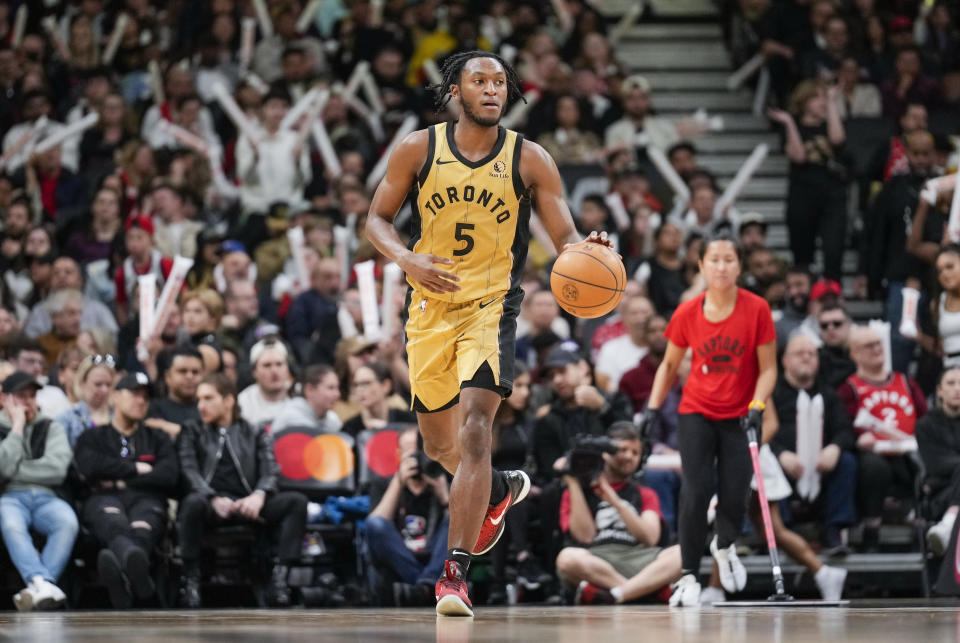
Restricted free agent Immanuel Quickley has agreed to terms on a five-year, $175 million contract to remain with the Toronto Raptors, according to ESPN’s Adrian Wojnarowski.
The 25th overall pick in the 2020 NBA draft, Quickley spent his first three and a half seasons with the New York Knicks, serving primarily as a point guard for head coach Tom Thibodeau. He became a fan favorite at Madison Square Garden for his combination of speed in transition, quick three-point shooting, excellent point-of-attack and help-side defense, and his penchant for turning games every time he was on the line.
There was also the jump:
New York’s net rating was 8.1 points per 100 possessions better with Quickley on the court than off it in 2020-21, 12.2 points per 100 better in 2021-22 and 8.5 points per 100 better in 2021-22. 100 better in 2022-23 – a stellar third season in which the Kentucky product averaged 14.9 points on 45/37/82 shooting, with 4.2 rebounds, 3.4 assists and 1 interception in 28.9 minutes per game and finished second in Sixth Man of the Year voting. (Full disclosure: I had it first on my ballot.)
Quickley’s per minute/per possession production and excellent advanced analytical profile suggested he was a player who, given starting minutes and a heavier workload, could prove to be a hidden star at seen by everyone. But with Jalen Brunson establishing himself as a true superstar in New York — and Thibodeau visibly uncomfortable with the defensive drawbacks of pairing two smaller guards, regardless of the tandem’s sparkling roster data — it didn’t seem likely that Quickley would get that sort of thing. track on Broadway. And with a costly decision on his future in the form of his restricted free agency looming, the Knicks opted to part ways with Quickley, sending him to Toronto along with forward RJ Barrett in exchange for 3-and-D wing OG Anunoby , reserve big man Precious Achiuwa and backup guard Malachi Flynn (who would later throw one of the most random 50 balls in NBA history).
Much of the attention and analysis after the trade focused on Anunoby’s role in transforming the Knicks into a 50-win team that looked, if briefly, like a title contender. On the other side of the trade, however, Quickley stepped into his starting point guard role for the first time, averaging nearly 35 more touches per game as a Raptor than he did as a Knick and nearly doubling his average time of possession.
He struggled at times in his first attempt to shoulder the shot-creating workload on a team devoid of a ton of offensive talent. The Raptors scored just 112.6 points per 100 possessions with Quickley on the court, which is exactly 24th in Toronto’s offensive efficiency rating all season.
But for the most part? Quickley looked the part:
In 38 starts for a Raptors team struggling to find a new normal after trading away longtime mainstays Anunoby and Pascal Siakam in an effort to rebuild around new cornerstone Scottie Barnes, Quickley averaged 18.6 points, 6.8 assists and 4.8 rebounds in 33.3 minutes per game. He shot 39.5% from three-point range on 7.1 attempts per game and 84.1% from the free throw line on four attempts per night. His assist rate skyrocketed, dishing out assists on a career-high 29.5% of his teammates’ baskets. His turnover rate remained low, with turnovers on just over 10% of the possessions he used.
Only four NBA players have averaged at least 15 points per game while posting such a high assist rate and such a low turnover rate over the course of a full season. The list: MVP finalist Shai Gilgeous-Alexander, All-NBA selection (and former Quickley teammate) Brunson, NBA champion Jamal Murray … and Fred VanVleet, Toronto’s longtime triggerman in whose role Quickley joined the revamped Raptors.
The 6-foot-3 guard has room for improvement. A look at the standings makes it clear that those strong individual stats haven’t necessarily translated into wins; Toronto went 12-26 in Quickley’s 38 starts and was outscored by 5.7 points per 100 in his minutes, according to Cleaning the Glass.
As Quickley increased his usage, his scoring efficiency declined, particularly from inside the arc; he shot just 34.8 percent from the deep end to the 3-point line in Toronto, and while he shot a healthy 70 percent from the field after joining the Raptors, he struggled to generate shots to the cup throughout his career. (The increased patience he showed at times on his drives later in the season could help a lot.) He needs to get more comfortable with the kind of blitzes and traps that a prolific 3-point shooter and downhill driver will have to deal with as a full-time point guard. He’ll also need to develop the conditioning and consistency that will allow him to remain a useful defensive contributor while handling heavier duties on offense.
In broad outline, however, the first glimpses of the big ideas behind the deal — Let’s try to find a good partner for our huge, versatile All-Star forward And we think this lightning-fast sixth man can evolve – were pretty solid. Over the entire season, the Raptors were outscored by 528 points in just under 4,000 minutes. But in the 600 minutes during which Barnes and Quickley shared the floor? They were plus-15.
This is not a guarantee of future greatness, but East A good starting point. Last season, the list of players who averaged 19 points, four rebounds and four assists per 36 minutes on average or above league average shooting during their first four campaigns is littered with All-Stars ; Quickley is now on that list. It remains to be seen whether the 25-year-old will join his predecessors in winning the league’s highest honors. This new contract, however, means that he will have the opportunity to earn his place in their company.